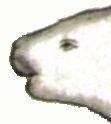The Pekarski Picture
This drawing is found as a scroll in the upper left hand corner of a map of Bering's travel route, produced 1744 by Sven Waxell and Sofron Chitrow for the Petersburg Admirality. The map itself was not published until 1893, but already 1869 Pekarsky included a lithographed copy of the scroll in his
"History of the Imperial Academy of Sciences"*)Istorija Imperatorskoj Akademii Nauki v Peterburge.
Stejneger
*)1936, App. A considered it to be
"the most authentic of the various copies preserved".
To Dr. Hintzsche
*)1996 this is "
probably the only picture of the seacow drawn after nature".

head enlarged |
It can however be argued that the arms have indications of fingers, that the contour of the upper arm is shown outside the body up to the shoulder. The eye is rather large and human like with eyebrow and corner, while Steller had described the eyes as "no larger than a sheep’s eyes. They are not provided with shutters, or lids, or any other external apparatus, but protrude from the skin through a round opening, scarcely a half inch in diameter". Nostrils are falsely shown at the tip of the rostrum.
One may suspect that two years after the voyage the chartmakers Waxell und Chitrov have from their memory added certain incorrect details to Plenisner's rough contour sketch.
In the upper right corner the chart shows a picture of an "American" in his baidar, who approached the St. Peter near the Shumagin Islands. This is probably also copied from a Plenisner sketch.
Several very crude later copies of this chart exist in Russian archives.


